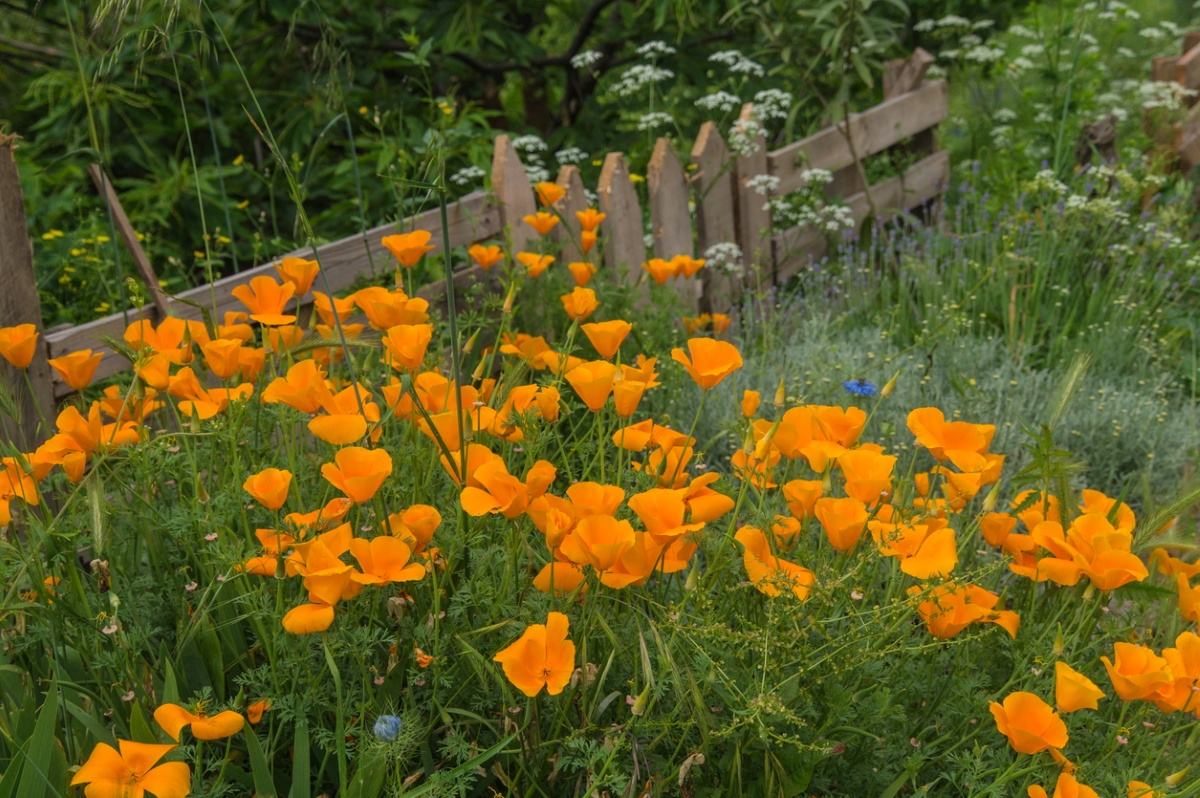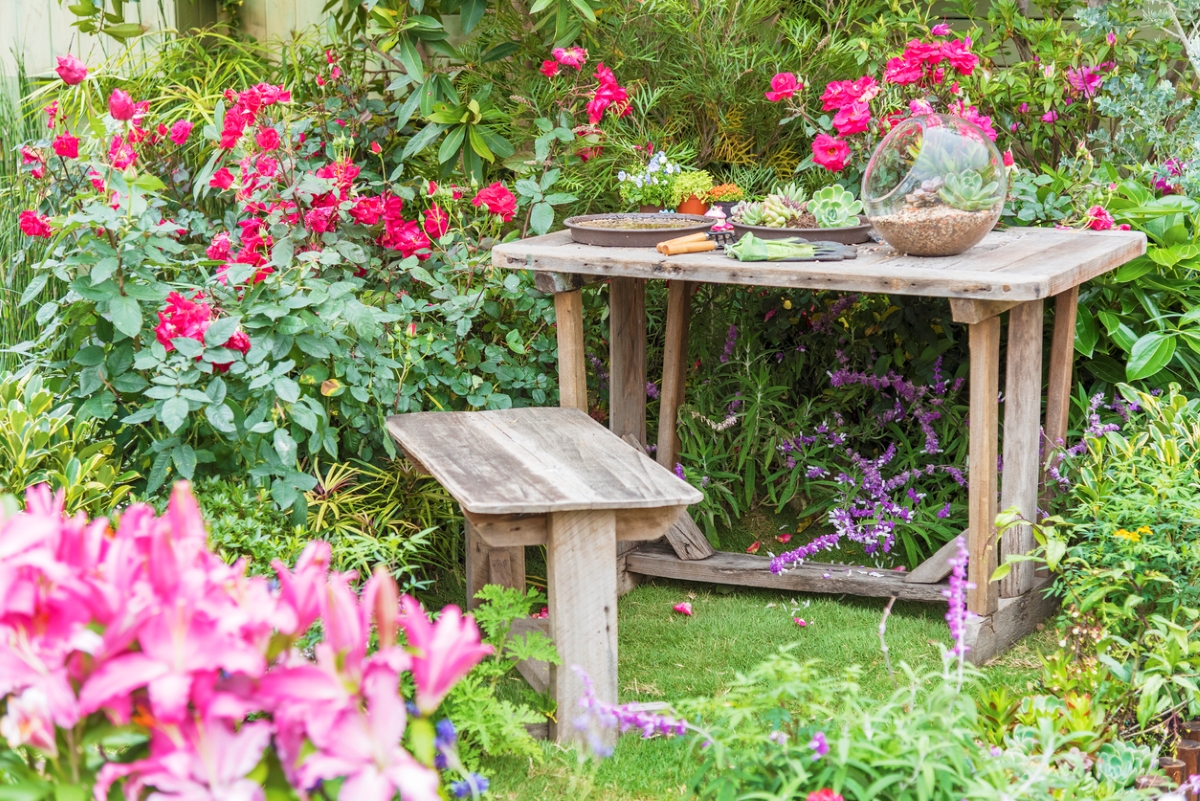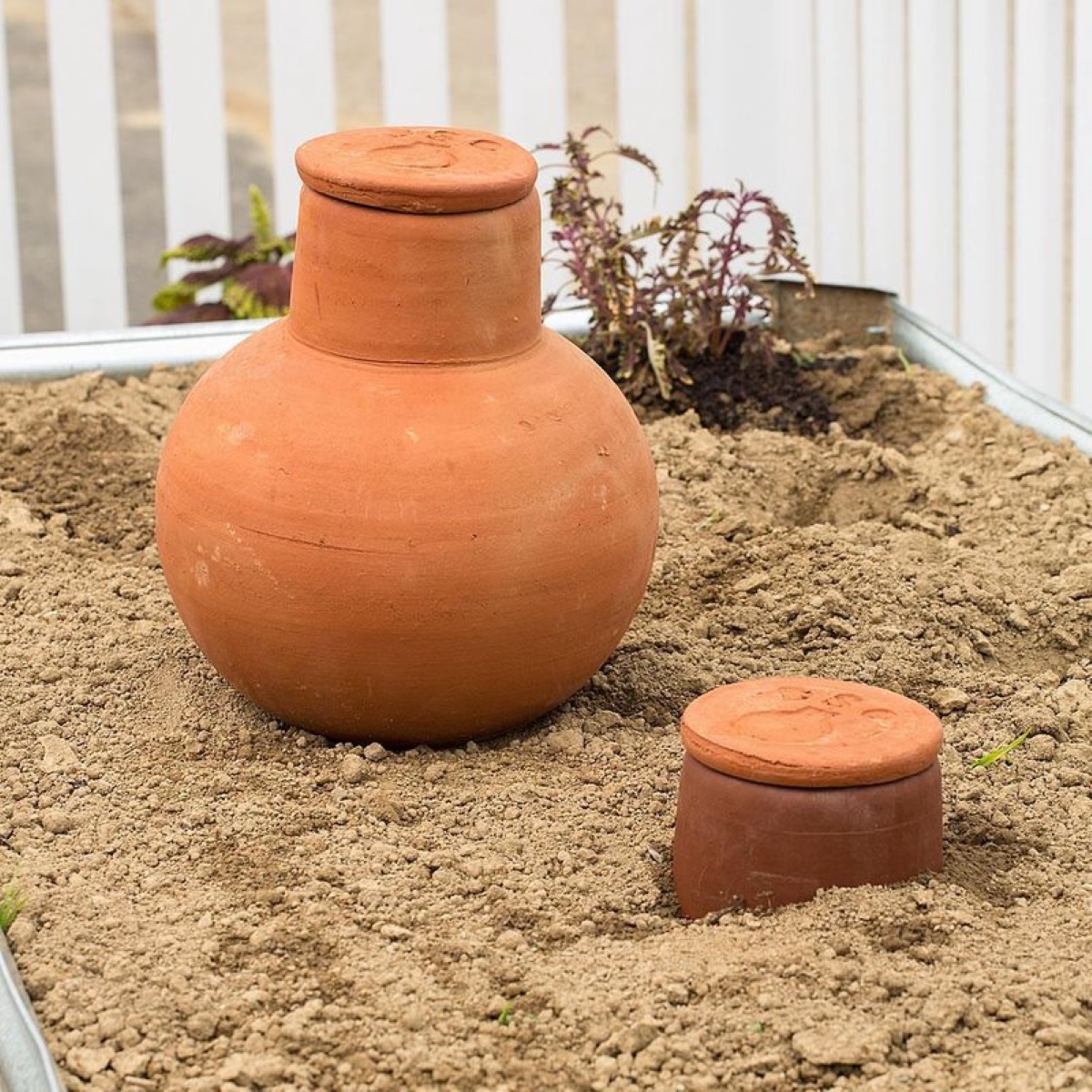We may earn revenue from the products available on this page and participate in affiliate programs. Learn More ›
Some people love the backbreaking business of taking care of their lawn and garden. Then there’s the rest of us: We’d rather relax and let our little piece of heaven largely take care of itself. Ahead, find easy landscaping ideas to make your outdoor space the envy of the neighborhood.
1. Replace some lawn with functional hardscaping.

Less lawn equals less work. That’s the best argument for hardscaping—that’s the use of pavers, brick, or decorative stone. Whether you opt for a patio or lay garden paths, you’ll have a durable surface that never needs weeding or watering, although you might want to sweep it occasionally. Options abound, from neat grids to a patchwork effect—great low-maintenance front yard landscaping is just a stone’s throw away.
RELATED: 9 Ideas for a Beautiful Brick Patio
2. Plant easy-care perennials.

Perennials are the gift that keeps on giving, season after season, unlike annuals, which you have to plant every year. Some perennials are more carefree than others, though. Forgetful gardeners will love the drought-tolerant pasqueflower or the delicate-looking but durable penstemon. For hot and dry climates, we like brilliant sedum, and, yes, yarrow (don’t dare call it a weed!).
RELATED: 50 Plants That Thrive in Any Yard
3. Opt for native plants throughout the landscape.

Plants adapted to their environments long before people did, so native species are a wise choice for the laid-back landscaper. Native plants require less fertilizer, water, pesticides, and overall care than plants brought in by settlers. To learn what will thrive in your neck of the woods, type “native plants” and your state into a search engine—you’ll find tons of info.
RELATED: 34 Amazing Plants That Are Native to North America
4. Lay some artificial turf.

Artificial grass has come a long way since your granddad’s Astroturf. Today’s synthetics, made of nylon or polymer, have varying heights and color gradations to look and feel more like the real thing. You can even plant a tree in it. Though pricey ($7 to $18 per square foot), your faux lawn will be absolutely fuss-free.
RELATED: You Might Mistake Our Favorite Artificial Grass for the Real Thing
5. Plant evergreen trees, shrubs, and ground covers.

What could be simpler than plants that keep their vivid, verdant color all year long? Put dwarf varieties into flower beds, set shrubs near your house to disguise the foundation, choose tall, columnar types for privacy—there are even creeping varieties for ground cover.
RELATED: 20 Evergreen Shrubs to Beautify Your Garden Year-Round
6. Use monkey grass for low-maintenance borders.

For interesting edges without the effort, try clumping monkey grass (Liriope muscari) along flower beds, borders, and walkways. This Asian native is hardy and stands up to dogs, deer, bugs, and weeds. As a bonus, it grows well in a variety of soils and climates. Monkey grass can grow to about 15 inches, so trim it if you wish or go long.
RELATED: 20 Plants to Use as Lawn and Garden Borders
7. Select fewer trees and shrubs for less maintenance.

Here’s a tip that’s particularly relevant for those looking for small front yard landscaping ideas: Less is more. Rather than crowd a bed with lots of plants you’ll need to tend, put in just a few high-impact, high-performance varieties. Planting one or two nice trees and some powerhouse perennials gives you more time to sack out in the hammock.
RELATED: 20 Tiny Backyards We Love
8. Plant hardy succulents in sunny areas.

If watering falls low on your to-do list, succulents (like echeveria, agave, and sedum) are your garden go-tos. Tough, colorful, and captivating, they also play well with others, so mixing ’em up adds more excitement to your landscape. Drainage is key, however: Depending on your local soil, you might be better off putting these shallow-rooting, sun-loving plants in raised beds with porous, well-aerated soil.
RELATED: Solved! Why Are My Succulents Dying?
9. Grow self-cleaning roses for color with little effort.

A rose by any other name probably isn’t as easy as Knock Out roses. These set-’em-and-forget-’em flowers are heat-resistant, pretty much prune-free, and “self-cleaning”—you don’t even have to deadhead them. Just use a good organic rose food in early spring, and follow up with foliar feedings (liquid fertilizer applied to the leaves) through the blooming season.
10. Raise plants suited for your growing zone.

Remember to pick plants suited to your USDA hardiness zone. Anything too tender is destined to fail, and who needs the frustration? While you’re at it, a soil test will diagnose your dirt and tell you what nutrients it might need to keep your plants low maintenance or help you select the best plants for your soil type. Your local extension office can help advise you, too.
RELATED: The Best Soil Test Kits According to Our Tests
11. Build paths or patios with gravel.

Strew irregularly shaped landscaping rocks around for the no-sweat simplicity of paving with a softer, more organic vibe. Gravel can be either man-made, which is ideal for high-traffic areas, or natural (smoother but less stable—so use where traffic is light). To keep the space looking spiffy, banish errant leaves as necessary with a wire-tined rake.
RELATED: The Best Gravel for Driveways
12. Replace grass with no-effort ground covers.

Give your mowing muscles a rest—and lighten your water and fertilizer load—by swapping traditional turf for a no-effort ground cover. These plants create a pleasingly plush carpet, and there are enough varieties to suit just about any climate and traffic condition. Consider mat-forming creeping perennials like New Zealand brass buttons (Leptinella squalida), Scotch or Irish moss (Sagina subulata), or low-growing clover.
13. Automate watering tasks.

Remembering to stay true to your watering routine can be tricky. Take steps to automate it so you’re less apt to forget. If you have an irrigation system, set up the timer based on what’s appropriate for the season. And if you don’t have underground sprinklers, you can still automate the process by purchasing a timer that attaches to your hose bib. Your grass will thank you.
RELATED: The Best Sprinkler Controllers for Lawn Care
14. Choose low-maintenance shade trees.

When selecting trees for your landscape, choose those that are low maintenance to avoid having to spend your free time cleaning up a carpet of spent blooms, hickory hulls, or invasive seedlings. Opt for evergreens and standard shade trees that don’t drop a lot of extras or reseed themselves all over the lawn.
RELATED: The 15 Best Trees for Any Backyard
15. Mulch fallen leaves with a mower.

Why spend hours and hours of your fall weekends raking leaves? Run over leaves with the lawn mower to make a mulch that will act like a superfood for your lawn. Keep the layer of mulched leaves no thicker than 1 inch to avoid creating thatch; use any extra to mulch garden beds.
RELATED: The Best Mulching Lawn Mowers, Vetted
16. Lay fabric barriers to cut down on weeding.

The more time you invest up front putting down weed barriers in your landscaping beds, the less time you’ll spend battling the unwelcome plants later. Just be sure to choose fabric barriers that are permeable enough to let water run through, especially near any tree. Use the fabrics under gravel or mulch paths you add as well. Contending with fewer weeds equals more time relaxing with family and friends—it’s a win-win.
RELATED: The Best Weeding Tools, Tested and Reviewed
17. Add maintenance-free rock mulch.

Want an easy way to cross a major spring and fall project off your to-do list? Replace organic material mulch like wood chips or pine straw with pea gravel or river rocks (or crusher fine in paths). These options require much less maintenance and don’t need to be refreshed every year. For best results, aim for a 2- to 4-inch layer of rock, with the thinner layer for small-particled rock. If any weeds pop through, take the little bit of time needed to pull them right away. Once weeds go to seed, you can expect even more of the same next year.
RELATED: 8 Ways to Upgrade Your Backyard with Pavers
18. Use watering tools to your advantage.

That timer on your hose or sprinkler system can automate lawn watering, but what about your garden beds and vegetable beds? A few tools can ease this burden. Start by laying out a soaker hose and covering it with a thin layer of mulch to protect it from the elements. Then set a reminder on your phone to run it as needed, or use an automatic hose timer.
Speed up your watering even more by investing in a quick connect system. This handy innovation makes it easier to thread hoses to soaker hoses and sprayers, or switch out watering tools. Install a male end on the soaker and sprayer and a female end on the main hose. When it’s time to change watering tools, just pull back on the female end and pop it onto the connector.
RELATED: The Best Lawn Sprinkler Systems, Tested
19. Choose plants that make new plants.

Although some flowers grow only as annuals in your area, you might be able to save time by starting them the first year, and leaving them to self-seed so new plants just appear out of the ground spring after spring. Productive seeders worth consideration include colorful cosmos, California poppies, giant larkspur, nigella, and portulaca. On the herb side, try dill (a host for butterflies) and parsley. Best of all, it’s your neglect that helps them reproduce. Leave the faded flowers on, especially toward the end of summer, to allow seeds to drop or blow in the wind and maybe even feed a few birds.
A similar strategy is to choose plants that spread via runners. Many good candidates are ground covers like creeping Jenny, but some edible plants, such as strawberries and mints, also send out runners and reroot. Leave them to spread as they will or control them as needed.
RELATED: Plant Propagation 101: Easy Techniques for Beginners
20. Go ahead and repeat plants that work.

Once you get the hang of caring for a native or otherwise low-maintenance plant, add another one. If you lose a shrub, replace it with a duplicate of one that worked for you. It’s likely that any plants that have thrived in your conditions and care (or even your benign neglect) will be good bets going forward, as long as the sun exposure and soil are similar from one spot to another.
If you think owning several of the same plant is just too lazy, think again. A tenet of landscape design is the “rule of threes”: To unify the landscape, repeat elements in groups of threes or in other odd numbers. For instance, you might place three matching Knock Out roses irregularly in the landscape, plant a line of three ornamental grasses, or station three identical containers along a wall.
RELATED: 30 Low-Maintenance Plants for Your Easiest Garden Ever
21. Collect or redirect rainwater.

Catching rain in a well-designed rain barrel is an eco-friendly way to garden, saving nature’s moisture for dry times. Truth be told, however, a rain barrel needs periodic cleaning and should be emptied before winter, so it tends to add to your landscaping tasks. Another option is to simply redirect the rain. If you can force the water that pools under your downspout to travel 15 feet away to your tree, you can prevent puddling and reduce the time (and water) you would otherwise have had to commit to irrigating the tree.
There are several ways to do this: One is a French drain, which requires some work up front but allows you to direct the water underground toward the thirsty target. An easier DIY project is to create a dry riverbed by digging a gentle slope from the ground below the downspout to the perimeter around the tree, and then filling the pathway with rocks, gravel, or river rock.
RELATED: 17 Rain Barrels That Make Water Conservation Stylish
22. Encourage natural pest control from predators.

There is nothing more natural than critters eating other critters, so do your best to encourage natural predators to visit your property and take care of undesirable pests. Attract barn owls, which feast on flying insects and rodents, as well as other helpful pest-eaters like woodpeckers, bluebirds, and cardinals, by providing water in the form of a bird bath and appropriate shelter, such as nesting boxes or even dense shrubbery—which mean less pruning for you! You can also try introducing lady beetles or other beneficial insects into your landscape and hope they stick around.
RELATED: The Best Bird Baths, Tested and Reviewed
23. Add self-watering tools to containers.

Containers add pretty color to your landscape, but they can dry out quickly and need to be watered more often than beds. You can invest in an outdoor self-watering container for herbs or ornamental plants, or purchase a few simple tools. For instance, try plant stakes that draw water from a reservoir, or take a tip from ancient irrigation techniques and bury an olla jar in a container or garden bed to provide consistent water that seeps through the clay. You will have to fill your olla jar or other watering tool periodically, but not every day, and that slow, steady seeping or dripping is better for the plants than rushed, inconsistent watering.
RELATED: 9 Brilliant Ways to Put Your Garden on Autopilot
24. Use chickens or other livestock to take on some of the work.

Although keeping a few farm animals on your city lot requires some attention (and familiarity with local zoning requirements), animals like chickens can ease the burden of pest control or other landscape duties. Chickens love grubworms, nab grasshoppers, and also scratch into soil to reach other insects and larvae. Not only can they help control the beetles that are damaging your plants, but they’ll also provide free fresh eggs and manure to enrich your compost pile. Ensure the safety and comfort of your small flock with a portable chicken coop like the Omlet Eglu Go UP, the best plastic option in our researched guide to the Best Chicken Coops.
In addition to chickens, consider raising geese, which eat grass and some weeds but avoid large-leaf plants. Geese even help protect chicken flocks by honking a warning or chasing off predators—and, of course, they also produce eggs. Pygmy goats are small and friendly, and they’re excellent foragers, grazing on grass and weeds. They can also produce milk. Just keep them away from shrubs and herbs, which they are prone to munch on.
25. Plan ahead and keep track.

As with any endeavor, up-front preparation trumps time spent fixing mistakes. When planning for or altering a landscape, do plenty of due diligence. Low- or no-maintenance landscaping begins with picking the right plant for the right spot. For example, you might love roses but not realize they need at least 6 hours of sun to thrive. Similarly, don’t place a drought-tolerant plant in a low spot where water pools, and remember that cold-hardy plants will survive winter better growing on the north side of your house than will heat lovers.
It also helps to keep track of what works and what doesn’t in your growing conditions. You don’t have to start a garden journal, but you might want to take some notes or photos to help you track planting times, when to prune, or when you last fertilized a shrub. As you plan, note that shade from trees changes during the day, with the seasons, and as trees mature. Take photos if you’re considering placing a vegetable bed near shade from a large tree. A little bit of prep can refresh your mind and save you from repeating mistakes.


